- Home
- Bertolt Brecht
Berliner Ensemble Adaptations Page 2
Berliner Ensemble Adaptations Read online
Page 2
* * * * *
I have dwelt on the adaptation of The Tutor at length because it offers a model for how the other adaptations in this volume also developed. The emphasis on clarity, the social rather than the individual dimension, and the idea that text can only be properly developed in rehearsal runs through the BE’s work under Brecht’s leadership. The one adaptation which did not make it to rehearsal in Brecht’s lifetime was Coriolanus. As a result, the text we have is incomplete, especially, as Ralph Mannheim notes, around the battle scenes at the end of Act One. However, it should not be overlooked that rehearsal itself might well have revealed more about the initial adaptation and that the final version might have looked very different from the version Brecht in fact left after he stopped working on it in 1953. Indeed, when the BE finally staged the play in 1964, the directors Manfred Wekwerth and Joachim Tenschert spent much time with a battery of assistants adapting the adaptation. The final BE script contained roughly 10 per cent of material added after Brecht’s death.
It was a logical progression for Brecht to move from Lenz to Shakespeare, and he said as much in a Journal entry of 22 December 1949. Brecht rated Shakespeare as the greatest realist of the bourgeois stage, yet realism here does not denote the faithful reproduction of everyday appearances, as is the case with plays by Chekhov, for example, or Arthur Miller. What Brecht meant was that Shakespeare understood how characters behaved and acted under the pressure of their historical situation – this was the ‘reality’ Brecht sought beneath surface appearances. The characters’ language may, of course, be poetic and metaphorical – nobody actually talks like that. To Brecht, it was the attitudes towards reality encoded in such speeches that rendered them ‘realistic’. Performing such realism was not easy and so The Tutor, inspired by Shakespeare’s dramaturgy, offered the BE, and particularly its young actors, an opportunity to develop the skills demanded by Brecht’s realistic theatre before the cast and crew confronted the master of the genre.
As much as Brecht admired Shakespeare, he still felt that there were characters and events that required further adaptation. The ‘Study of the first scene of Shakespeare’s Coriolanus’ (to be found on p. 450 of this volume) demonstrates the ways Brecht interrogated the material he found. The ‘study’ is not a verbatim account of a meeting, in which Brecht is represented by a ‘B’; he rewrote it in order to emphasize certain salient points. B’s role here is to stimulate dialogue by asking questions and making observations about the text as it stands. On occasion, he notes that Shakespeare was writing for a different kind of theatre, one of a class society. Brecht and the BE, on the other hand, were planning a production in a socialist state, and this shift of context provided the main reason for an adaptation. Brecht sought to undermine the prejudices against the working people of Rome that pervaded Shakespeare’s time and to undermine the implicit dominance of the patricians. In response, the people’s tribunes became more credible characters in their own right than mere intriguing politicians who have a personal problem with Coriolanus himself. The common people were also recast. Shakespeare’s IV iii became Brecht’s IV i, for example, and the scene was completely rewritten. Rather than making the banishment of Coriolanus the focus, two men, a Roman and a Volscian, consider how the world is safer without Coriolanus, but they are more concerned with their common social plight away from the tribal wrangles. The workers of this world most certainly unite, because they understand that they share a common set of problems defined by their place on the lower rungs of the social ladder.
The last scene also presents a very different finale: rather than the dramatic murder of Coriolanus at the hands of Aufidius and his men, the audience is returned to a more tranquil and understated setting, the Roman Senate. Life goes on and the politicians are going about their legislative business when news of Coriolanus’ death arrives. Menenius asks that the vanquished general’s name be inscribed in the Capitol but the politicians continue their meeting. The family is also denied the honour of wearing public robes of mourning for ten months, a decision that inverts the ending of Shakespeare’s play. This final scene is also interesting in that it features senators, a consul, and the tribunes. That is, the defeat of Coriolanus and the relegation of his importance has not suddenly led to social revolution: the noble senators are still present in the legislature. However, the tribunes are the ones who reject the two proposals to memorialize the man who ultimately betrayed Rome, despite his victories earlier in the play. Power is shifting, but is not in the tribune’s hands yet.
Brecht was also troubled by the figure of Coriolanus himself because he represented one of Shakespeare’s ‘great individuals’. These characters appeared to be imbued with character traits that resisted social categorization, that is, they were seemingly ‘given’ naturally, something Brecht found difficult to accept. Instead he read Coriolanus as a specialist in war who overestimated his own value. Viewing himself above and apart from society, he mistakenly believed he was indispensable. Brecht showed how the people of Rome went on to arm themselves against further attack from the Volscians under Coriolanus in order to point out Coriolanus’ more peripheral status. His tragedy in Shakespeare is his pride; in Brecht he falls because of his individualism, a category which is social as well as personal. He fails to realize that the upper echelons of Roman society indulge him his individualism when he is in favour but that the people, in the form of the tribunes, reject it when he fails to play his role in the political process. Brecht thus retained the element of tragic pride but re-contextualized it in the power networks of Roman society.
* * * * *
The social element also provided the focus when Brecht and Benno Besson adapted Anna Seghers’ The Trial of Joan of Arc at Rouen, 1431. The original radio play mostly emphasized the trial, yet the adapters sought to bring in the on-stage audience far more prominently as a way of creating a fuller picture of French society under English rule. Besson, who directed the production, acknowledged that this was his first show in which he clearly understood the way socially defined contradictions manifested themselves on stage and changed as events changed. The new script thus allowed him to construct contradictions, resolve them and develop them with new ones. Indeed, the expansion of the crowd scenes led to experiments with the staging, in that Besson used approaches taken from Stanislavsky in order to individualize the representative crowd more ‘realistically’. The BE found that Stanislavsky could be integrated into the BE’s working methods as long as the focus of the work remains social rather than psychological. The individuality brought out from the members of the crowd emphasized details of their social origins and attitudes, and made plain how these factors altered as new information and relationships emerged in the light of the trial.
Don Juan initially started as a project commissioned by another theatre, the Volkstheater Rostock. Besson had been out of favour at the BE because he had lost the rehearsal notes to The Tutor and was invited independently of Brecht to direct any play of his choice. Having been involved in the adaptation process at the BE, he chose Molière’s play because he considered it formally weak in comparison to the rest of the French playwright’s oeuvre. He was particularly concerned by the way the action seemed to drag in the original’s final two acts and so he conflated them into what is the final act of the adaptation, Act Four. Elsewhere we notice again the introduction of new characters and situations in a bid to expand the social reach of the play.
Besson reported that he and Brecht’s long-standing collaborator Elisabeth Hauptmann started translating and adapting the text when Brecht got wind of the project and that Brecht then took a leading role. A transcript of a meeting that Brecht chaired, which appears to be verbatim rather than the edited text on Coriolanus discussed above, again shows how actively Brecht sought to problematize the texts staged by the BE. In this discussion, he particularly focused on what comedy meant in Don Juan, but rather than offering his own theses, he employed an interrogative mode, persistently posing questions to tease out
the meaning of the genre in the context of the Don Juan myth, which is usually considered tragic. His constant questioning did not settle on the answers given by his collaborators but used them only to probe further.
Again the central figure proved problematic and Brecht was keen to process the reviews the production garnered in Rostock in order to correct some of its perceived flaws and to improve upon them. Brecht objected to the position that Don Juan’s atheism was in some way progressive (see ‘Don Juan as a character’, p. 478 of this volume). He preferred to view it as a mark of Don Juan’s decadence in a decadent court, an absence of faith rather than the militant championing of a cause. Again, social contradiction is central to Brecht’s thought: Don Juan’s hedonism makes him lazy, and his hedonism is an index of the state of the court in pre-revolutionary France. Brecht wanted Besson to bring out these aspects as comic and laughable. This Besson did when he directed the play afresh as the curtain-raiser when the BE finally moved to the Theater am Schiffbauerdamm in early 1954. That Brecht chose to open the new venue with a play written by another dramatist and directed by one of his assistants and not himself shows how he was happy not to hog the limelight but to promote the talent of others. Brecht certainly played a major role in both the adaptation and the direction. As he told Besson afterwards, he was happy to help, but he would have staged the production quite differently and so he wanted Besson to take the credit as sole director.
Brecht followed up the success of the adapted Don Juan with another comedy, taken from a different tradition. George Farquhar’s Restoration Comedy The Recruiting Officer formed the basis of Trumpets and Drums. One of the most obvious changes is historical: Farquhar’s original settings taken from his own time, the beginning of the eighteenth century, shift forward to the American War of Independence, much later that century. This decision appears to have been taken in a bid to make the action more accessible for the German audience. Spectators would have found it easier to understand the tensions associated with imperialism, although this could have led to a political issue concerning the positive portrayal of the Americans at a time when they played the role of imperialist aggressor in GDR cold-war propaganda.
As it happened, this was not the case. Instead, the ruling Socialist Unity Party (abbreviated in German to ‘SED’) had more pragmatic concerns. As John Willett notes in ‘Adapting Farquhar’, p. 490 of this volume, the main work on the adaptation took place between March and April 1955, yet the play was only premiered in September. The reason for this was that the cultural functionaries were concerned that the play, which has a critique of press-ganging as its theme, could be construed as pacifist. The Federal Republic of Germany was remilitarizing and founded the Bundeswehr a month after the premiere, and the GDR followed suit in 1956 with the formation of the Nationale Volksarmee (National People’s Army). The SED thus viewed pacifism as a position that undermined the planned establishment of its armed forces and did not want its most famous theatre producing work that could be interpreted as critical of the policy. In the period between adapting The Recruiting Officer and putting it on the stage, the BE set about insulating the text from any charge of pacifism by focusing its critique on the issue of imperialist warmongering and the lengths to which the British would go to fight their war of subjugation, rather than as a blanket condemnation of military action.
* * * * *
This, however, was not the only occasion on which the SED intervened in the BE’s plans regarding adaptations. Indeed, adaptations were much contested because of their implication in a major aspect of GDR cultural policy. The SED viewed the GDR as the inheritor of a progressive German tradition and used this usurped authority as a way of distancing the GDR as a socialist republic from the catastrophe of Nazism. The way in which this political definition of the nation affected culture was in the treatment of the German cultural heritage. Productions of classic works were obliged to emphasize positive aspects in the plays in order to connect the present with those chosen and preferred parts of the past. It is thus not a little peculiar that the SED neither publicly nor privately censured The Tutor. Staging the ‘misère’ pointed out, after all, a deep-rooted historical inability of the German people to shape history in its own interests, and the production’s ironic happy ending would not have protected the BE against the charge of pessimism. To Brecht, on the other hand, the play and its ending were an example of a ‘negative example’, one in which the audience was confronted with the parody of an ideal with a view to suggesting its own improvements. The lack of pointers towards a brighter future would not have sufficed as a valid conclusion to the authorities, who banned Hanns Eisler’s Johannes Faustus in 1953 for its negative portrayal of Faust, the SED’s most cherished figure from the German canon.
The question then arises as to why the SED did not move against The Tutor in 1950. It is likely that three main factors led to the production failing to register with the SED’s cultural organs. First, The Tutor, as already noted, was not that well known. It would have been difficult to raise the Party’s hackles if it could not refer to an official line on the play. Similarly, the audience would have encountered performances ‘afresh’ with few, if any, preconceived notions about the play, its themes or its forms. That Brecht and his collaborators had made great changes may not have been all that noticeable, especially given the second item in the list of tasks for the adapters: that the play should retain ‘the elegance of the sequence of the scenes’. Second, the production was a great success. Audiences and reviewers alike praised its precision, its beauty, its lightness and its humour. The young ensemble had demonstrated how well it could function as a unit, and the production’s critique of an oppressive society was lively and engaging, not leaden and propagandistic. Third, the SED itself was uncertain how to wield its new power. The regime was still in a process of bedding down and culture was administered by a range of different agencies, ranging from the Central Committee, through the recently established Ministry of People’s Education, down to more local Berlin authorities. It is possible that the Party was not confident enough to launch an attack on a work that was at once unfamiliar and remarkably popular.
The same could not be said of Coriolanus. By 1951, the SED was firmly in control and had turned its opinions on the cultural heritage and other aspects of cultural policy into dogma. The Party officially adopted positions on various cultural matters at a conference held between 15–17 March 1951. After this date, it sought to impose its will more heavy-handedly, and, in a meeting in August 1951, it banned further work on the Shakespearean adaptation. The combination of the world’s most famous dramatist, whom the Germans had been calling ‘our Shakespeare’ since at least the eighteenth century, and a protagonist, who had certain affinities to Stalin, was enough to alert the Central Committee to the potential dangers of a production. Brecht did continue to work on the play, but kept the further adaptation quiet, partly for political reasons, partly because he could not secure a suitable male lead for the eponymous hero.
Another BE adaptation, not included in this volume, also came in for official criticism. In 1951, the company staged a fusion of two plays by Gerhart Hauptmann that featured the same lead character, one each side of the interval. The Beaver Coat is a full-blooded comedy, Red Hen a tragi-comedy; their joining did not make for great theatre, and the production was not well received despite the much-lauded performance of one of Germany’s most accomplished actors, Therese Giehse, in the main role of Mother Wolffen. The SED was not concerned about the success or failure of the production; it found the process of adulterating two classic plays by transforming them into one evening’s theatre at odds with its ideas on the purity of the cultural heritage and sought to remove the mongrel from the repertoire. In this case, however, the SED was beaten to its goal by Hauptmann’s estate which unknowingly shared the Party’s view and withdrew the rights after a mere fourteen performances. The estate explicitly objected to the act of adaptation because it had only granted permission for what it called a
‘dramaturgical arrangement’ of the material.
It is telling that the BE’s most controversial production in this early period of GDR history was deliberately kept ‘un-adapted’. The BE staged Goethe’s Urfaust, the early drafts of what would become the first part of Faust, in 1952 in Potsdam and 1953 in Berlin. After the diktats on Coriolanus and other works scheduled for the BE, Brecht was naturally wary. Nonetheless, he supervised the Urfaust production, which was directed by assistant Egon Monk, and approached it in much the same way he would any other production. That is, he mined it for contradictions and conferred on it a lively new reading, away from the orthodoxies of the day. The first production, which portrayed Faust as a charlatan and seducer, was initially praised in the local press but a letter from the Party group at the theatre that hosted the production was merciless in its critique of how the BE had betrayed the German cultural heritage. An adaptation would have merely given the Party more grist to its mill, in that Brecht would have been accused of ‘perverting’ the text to suit his ends. The preservation of the original text meant that he was only working with the material he found. The second attempt to stage the play in Berlin was deliberately toned down, in the light of the public criticism. Faust no longer had the negative traits that he had had in Potsdam; his tragic contradiction was predicated upon the position that he had to engage in a pact with the devil in order to pursue his more progressive ends. This radical shift in interpretation could not, however, save a production already sullied. The head of the Deutsches Theater, Wolfgang Langhoff, did not allow Urfaust to be performed to audiences as an evening show, and consigned it to matinees. After seven of these passed, and with no prospect of entering the normal repertoire, the production vanished, never to be seen again, although, ironically enough, young film-maker Hans-Jürgen Syberberg captured some of the rehearsals on his 8mm camera in 1953.

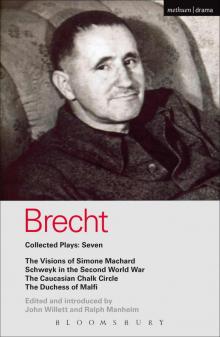 Bertolt Brecht: Mutter Courage und ihre Kinder 7
Bertolt Brecht: Mutter Courage und ihre Kinder 7 Bertolt Brecht
Bertolt Brecht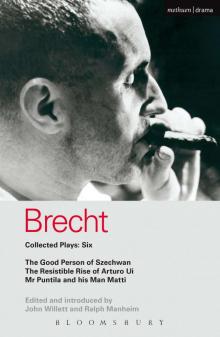 Bertolt Brecht: Mutter Courage und ihre Kinder 6
Bertolt Brecht: Mutter Courage und ihre Kinder 6 Bertolt Brecht: Mutter Courage und ihre Kinder 4
Bertolt Brecht: Mutter Courage und ihre Kinder 4 Bertolt Brecht: Mutter Courage und ihre Kinder 2
Bertolt Brecht: Mutter Courage und ihre Kinder 2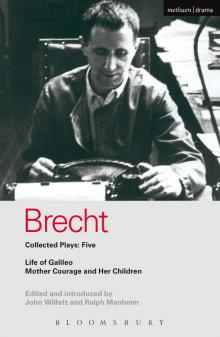 Bertolt Brecht: Mutter Courage und ihre Kinder 5
Bertolt Brecht: Mutter Courage und ihre Kinder 5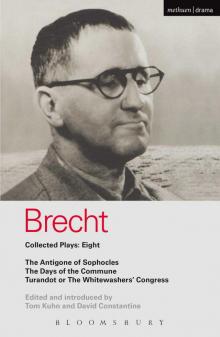 Collected Plays, Volume 4 (Bertolt Brecht: Plays, Poetry & Prose) 8
Collected Plays, Volume 4 (Bertolt Brecht: Plays, Poetry & Prose) 8 Mother Courage and Her Children
Mother Courage and Her Children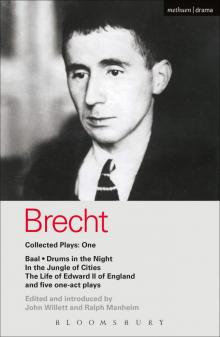 Bertolt Brecht: Mutter Courage und ihre Kinder 1
Bertolt Brecht: Mutter Courage und ihre Kinder 1 Brecht Collected Plays: 3: Lindbergh's Flight; The Baden-Baden Lesson on Consent; He Said Yes/He Said No; The Decision; The Mother; The Exception & the ... St Joan of the Stockyards (World Classics)
Brecht Collected Plays: 3: Lindbergh's Flight; The Baden-Baden Lesson on Consent; He Said Yes/He Said No; The Decision; The Mother; The Exception & the ... St Joan of the Stockyards (World Classics)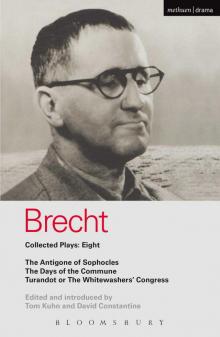 Brecht Plays 8: The Antigone of Sophocles; The Days of the Commune; Turandot or the Whitewasher's Congress: The Antigone of Sophocles , The Days of the Comm (World Classics)
Brecht Plays 8: The Antigone of Sophocles; The Days of the Commune; Turandot or the Whitewasher's Congress: The Antigone of Sophocles , The Days of the Comm (World Classics)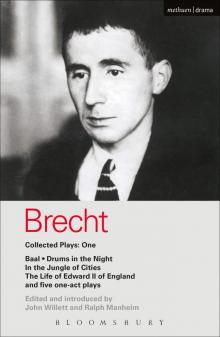 Brecht Collected Plays: 1: Baal; Drums in the Night; In the Jungle of Cities; Life of Edward II of England; & 5 One Act Plays: Baal , Drums in the Night , In the Jungle of Ci (World Classics)
Brecht Collected Plays: 1: Baal; Drums in the Night; In the Jungle of Cities; Life of Edward II of England; & 5 One Act Plays: Baal , Drums in the Night , In the Jungle of Ci (World Classics)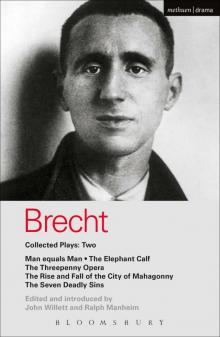 Brecht Collected Plays: 2: Man Equals Man; Elephant Calf; Threepenny Opera; Mahagonny; Seven Deadly Sins: Man Equals Man , Elephant Calf , Threepenny Ope (World Classics)
Brecht Collected Plays: 2: Man Equals Man; Elephant Calf; Threepenny Opera; Mahagonny; Seven Deadly Sins: Man Equals Man , Elephant Calf , Threepenny Ope (World Classics)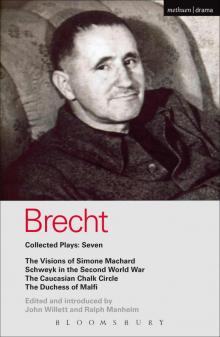 Brecht Collected Plays: 7: Visions of Simone Machard; Schweyk in the Second World War; Caucasian Chalk Circle; Duchess of Malfi (World Classics)
Brecht Collected Plays: 7: Visions of Simone Machard; Schweyk in the Second World War; Caucasian Chalk Circle; Duchess of Malfi (World Classics)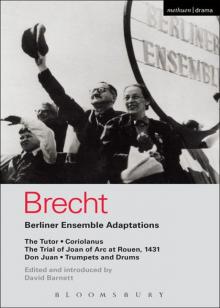 Berliner Ensemble Adaptations
Berliner Ensemble Adaptations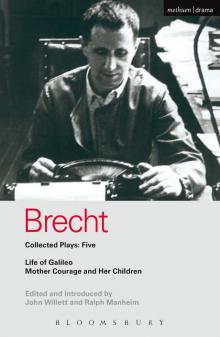 Brecht Collected Plays: 5: Life of Galileo; Mother Courage and Her Children (World Classics)
Brecht Collected Plays: 5: Life of Galileo; Mother Courage and Her Children (World Classics)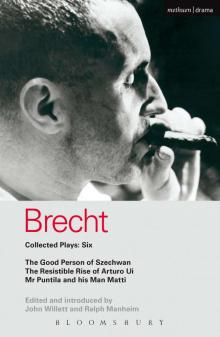 Brecht Collected Plays: 6: Good Person of Szechwan; The Resistible Rise of Arturo Ui; Mr Puntila and his Man Matti (World Classics)
Brecht Collected Plays: 6: Good Person of Szechwan; The Resistible Rise of Arturo Ui; Mr Puntila and his Man Matti (World Classics)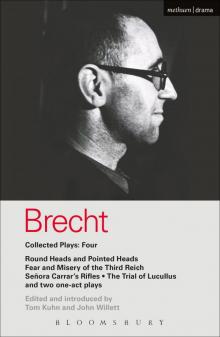 Brecht Collected Plays: 4: Round Heads & Pointed Heads; Fear & Misery of the Third Reich; Senora Carrar's Rifles; Trial of Lucullus; Dansen; How Much Is ... and Misery , Carr (World Classics)
Brecht Collected Plays: 4: Round Heads & Pointed Heads; Fear & Misery of the Third Reich; Senora Carrar's Rifles; Trial of Lucullus; Dansen; How Much Is ... and Misery , Carr (World Classics)